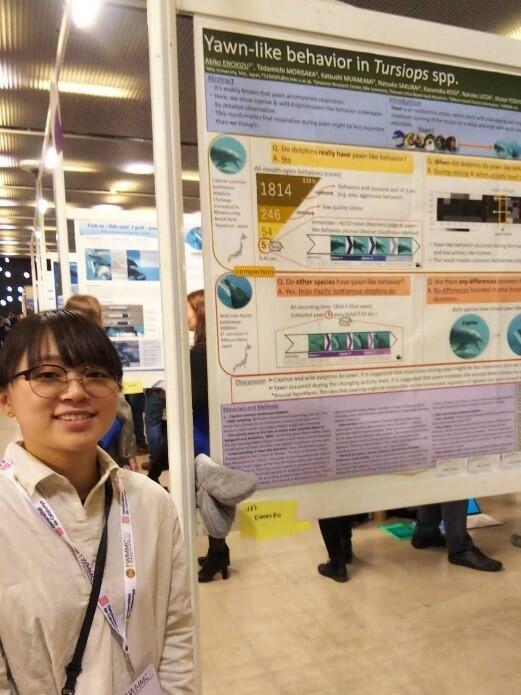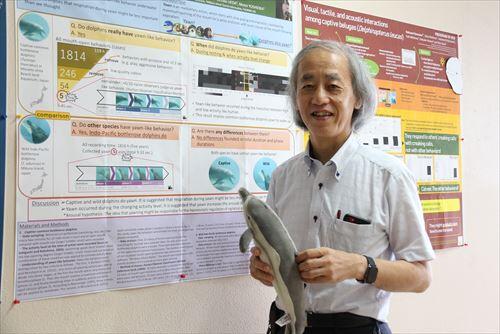Summary of our research
Ms. ENOKIZU Akiko (third-year doctoral student at Graduate School of Bioresources, Mie University) observed and recorded yawning in a captive dugong at Toba Aquarium, Mie, in a collaborative study under the supervision of Assoc. Prof. MORISAKA Tadamichi and Prof. YOSHIOKA Motoi. This was the second report of yawning in fully aquatic mammals (after bottlenose dolphins) and confirmed the existence of yawning behavior underwater.
Vertebrates, including humans, naturally yawn when they are sleepy. The traditional definition of yawning is, "An open-mouth behavior which begins with a slow opening of the mouth with inhalation, followed by a maximum gaping phase, and ends with a short exhalation and the closing of the mouth." However, after observing underwater yawning in bottlenose dolphins, we hypothesized that yawning may not require inhalation and exhalation. We then studied a captive dugong, another fully aquatic mammal; however, it belongs to an evolutionary lineage (sirenian) different from that of the bottlenose dolphin (cetacean). Ms. ENOKIZU observed dugong behavior for about 20 hours at the Toba Aquarium and recorded 14 instances of yawn-like behavior that fit into the definition of yawn-like behavior in bottlenose dolphins: "An open-mouth behavior which begins with a slow mouth opening, followed by a maximum gaping phase, and ends with a rapid mouth closing." We concluded that dugongs also exhibit yawning because the behavior was observed mainly during the resting state.
This study reported yawning in a fully aquatic group of mammals other than the cetaceans and supported our hypothesis that yawning does not necessarily require breathing. We recommend that the definition be changed as, "Yawning is an involuntary action and occurs in three phases: slow mouth opening, followed by a maximum gaping phase, and quick mouth closure." Although yawning is an "everyday" behavior, it continues to interest researchers because the origin, mechanism and function of this behavior still remain largely unknown.

Figure 1. Yawning in a captive dugong @ Toba Aquarium
The study described in this report was published online in the "Journal of Ethology" on November 27, 2021.
Observation of yawn-like behavior in a dugong (Dugong dugon)
https://doi.org/10.1007/s10164-021-00732-z
Researcher information

ENOKIZU Akiko
3rd grade of Doctoral Course, Gladuate School of Bioresources
Specialized area:
Ethology (Animal behavior)
Current research field:
Yawn behavior in fully aquatic mammals

MORISAKA Tadamichi
Associate Professor, Cetacean Research Center, Graduate School of Bioresources
Specialized area:
Bioacoustics, Ethology, Cetology
Current research field:
・ Description of interesting behaviors in cetaceans
・ Development of the elementary techniques for cetacean conservation
・ Basic study for cetacean communication and society

YOSHIOKA Motoi
Professor, Graduate School of Bioresources
Specialized area:
Marine mammalogy, Reproductive physiology
Current research field:
・ Understanding of the mechanism of cetacean reproductive physiology
・ Understanding of the life history of narrow-ridged finless porpoises in Ise Bay